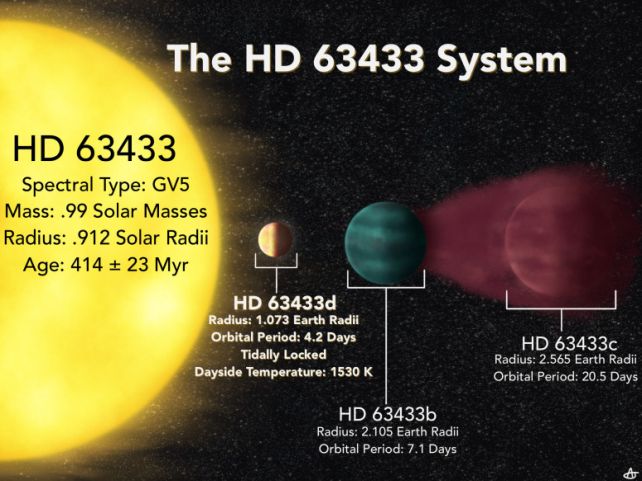An exoplanet discovered just 73 light-years away is offering a glimpse into what baby Earth might have looked like – if it was locked in a scorchingly tight orbit with its star.
The world is named HD 63433 d, a newborn exoplanet that's just a titch bigger than Earth, orbiting a star that is just like the Sun. It's the smallest planet we've found yet that is less than 500 million years old, a rare window into the formation of planets similar to, but not entirely like, our own world.
Earth is the only world that we know for a fact hosts life. Learning the different ways Earth-like planets can form and evolve, especially around Sun-like stars, helps scientists figure out the ingredients that allow life to emerge elsewhere in the Universe.
HD 63433 d is both very like and very unlike Earth, which means it represents a magnificent opportunity. And it's different from Earth in some pretty excitingly extreme ways.
"It's a useful planet because it may be like an early Earth," says astrophysicist Melinda Soares-Furtado of the University of Wisconsin-Madison, who co-led the research with astronomer Benjamin Capistrant of the University of Florida.
"Even though it's really close-orbiting, we can use follow-up data to search for evidence of outgassing and atmospheric loss that could be important constraints on how terrestrial worlds evolve. But that's where the similarities end – and end dramatically."
The Earth-sized world was discovered during a survey using the TESS exoplanet-hunting telescope that stares at stars, looking for faint, regular dips in starlight that signal the presence of an orbiting exoplanet. By measuring different effects that the exoplanet has on the star's light, astronomers can then work out its size and mass.
HD 63433 is a yellow dwarf star that is pretty much the size and mass of the Sun, with a similar temperature profile. But it is much, much younger, just over 400 million years old, compared to the Sun's 4.5 billion years. HD 63433 is, in stellar terms, just a baby; and so are the exoplanets orbiting it. So far, three exoplanets have been found – two mini-Neptunes, spotted in 2020, and HD 63433 d.

Transit data – those dips in starlight as it orbits – show that HD 63433 d is 1.1 times the radius of Earth. We don't know its mass yet, but that physical size strongly implies a terrestrial composition, a rocky world like Earth, Mars, or Venus.
The exoplanet whips round its star on an extremely tight orbit, once every 4.2 days. That means it and its star are extremely close together, so close that HD 63433 d is probably tidally locked, with one side always facing the star. Because that one hemisphere is always receiving the full brunt of the heat from the star, its surface is probably a permanent sea of molten rock, scientists say, with a dayside temperature of 1,570 Kelvin (1,297 Celsius or 2,366 Fahrenheit).
It's basically a huge lava ocean.
Earth, of course, was never this close to the Sun, but it could have reached temperatures as high as 2,300 Kelvin, following the collision that broke off a chunk of the planet to form the Moon.
There's a lot we still don't know about HD 63433 d; the team hopes that follow-up studies will tell us a bit more about it, including its mass; this, in turn, will allow scientists to calculate its density, which can tell us what the exoplanet is made of. We might even be able to determine if it has an atmosphere, and what that atmosphere has in it.
"This is our solar backyard, and that's kind of exciting," Soares-Furtado says. "What sort of information can a star this close, with such a crowded system around it, give away? How will it help us as we move on to look for planets among the maybe 100 other, similar stars in this young group it's part of?"
HD 63433 d is the closest known exoplanet to Earth with an Earth-like radius orbiting a young star. There's a lot this world has yet to teach us; we'll be hoping to hear more about it in the months ahead.
The research has been published in The Astronomical Journal.
https://news.google.com/rss/articles/CBMiYGh0dHBzOi8vd3d3LnNjaWVuY2VhbGVydC5jb20vbGlrZS1hbi1lYXJseS1lYXJ0aC1zY2llbnRpc3RzLWZpbmQtcGxhbmV0LWRyb3duZWQtaW4tb2NlYW4tb2YtbGF2YdIBAA?oc=5
2024-01-20 22:31:18Z
CBMiYGh0dHBzOi8vd3d3LnNjaWVuY2VhbGVydC5jb20vbGlrZS1hbi1lYXJseS1lYXJ0aC1zY2llbnRpc3RzLWZpbmQtcGxhbmV0LWRyb3duZWQtaW4tb2NlYW4tb2YtbGF2YdIBAA
Bagikan Berita Ini
















0 Response to "'Like an Early Earth': Scientists Find Planet Drowned in Ocean of Lava - ScienceAlert"
Post a Comment